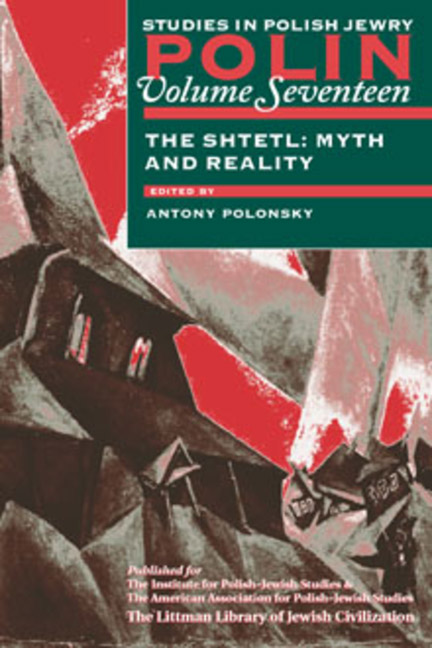Book contents
- Frontmatter
- Dedication
- Editors and Advisers
- Preface
- Polin
- Polin: Studies inPolish Jewry
- Contents
- Note on Place Names
- Note on Transliteration
- List of Abbreviations
- PART I THE SHTETL: MYTH AND REALITY
- Introduction. The Shtetl: Myth and Reality
- The Shtetl as an Arena for Polish–Jewish Integration in the Eighteenth Century
- Inter-Religious Contacts in the Shtetl: Proposals for Future Research
- The Hasidic Conquest of Small-Town Central Poland, 1754–1818
- The Drama of Berdichev: Levi Yitshak and his Town
- Polish Shtetls under Russian Rule, 1772–1914
- How Jewish Was the Shtetl?
- The Changing Shtetl in the Kingdom of Poland during the First World War
- The Shtetl: Cultural Evolution in Small Jewish Towns
- Small Towns in Inter-War Poland
- Jewish Patrons and Polish Clients: Patronage in a Small Galician Town
- Maintaining Borders, Crossing Borders: Social Relationships in the Shtetl
- The Soviet Shtetl in the 1920s
- Shtetl and Shtot in Yiddish Haskalah Drama
- Kazimierz on the Vistula: Polish Literary Portrayals of the Shtetl
- Imagining the Image: Interpretations of the Shtetl in Yiddish Literary Criticism
- Shtetl Codes: Fantasy in the Fiction of Asch, Schulz, and I. B. Singer
- Returning to the Shtetl: Differing Perceptions
- PART II NEW VIEWS
- PART III DOCUMENTS
- PART IV THE SIXTY-FIFTH ANNIVERSARY OF EVENTS IN PRZYTYK: A DEBATE
- PART V REVIEWS
- OBITUARIES
- Notes on the Contributors
- Glossary
- Index
Inter-Religious Contacts in the Shtetl: Proposals for Future Research
from PART I - THE SHTETL: MYTH AND REALITY
- Frontmatter
- Dedication
- Editors and Advisers
- Preface
- Polin
- Polin: Studies inPolish Jewry
- Contents
- Note on Place Names
- Note on Transliteration
- List of Abbreviations
- PART I THE SHTETL: MYTH AND REALITY
- Introduction. The Shtetl: Myth and Reality
- The Shtetl as an Arena for Polish–Jewish Integration in the Eighteenth Century
- Inter-Religious Contacts in the Shtetl: Proposals for Future Research
- The Hasidic Conquest of Small-Town Central Poland, 1754–1818
- The Drama of Berdichev: Levi Yitshak and his Town
- Polish Shtetls under Russian Rule, 1772–1914
- How Jewish Was the Shtetl?
- The Changing Shtetl in the Kingdom of Poland during the First World War
- The Shtetl: Cultural Evolution in Small Jewish Towns
- Small Towns in Inter-War Poland
- Jewish Patrons and Polish Clients: Patronage in a Small Galician Town
- Maintaining Borders, Crossing Borders: Social Relationships in the Shtetl
- The Soviet Shtetl in the 1920s
- Shtetl and Shtot in Yiddish Haskalah Drama
- Kazimierz on the Vistula: Polish Literary Portrayals of the Shtetl
- Imagining the Image: Interpretations of the Shtetl in Yiddish Literary Criticism
- Shtetl Codes: Fantasy in the Fiction of Asch, Schulz, and I. B. Singer
- Returning to the Shtetl: Differing Perceptions
- PART II NEW VIEWS
- PART III DOCUMENTS
- PART IV THE SIXTY-FIFTH ANNIVERSARY OF EVENTS IN PRZYTYK: A DEBATE
- PART V REVIEWS
- OBITUARIES
- Notes on the Contributors
- Glossary
- Index
Summary
MANY studies of the history of the Jews in Poland and Polish–Jewish relations stress the lack of inter-religious contacts between Jews and Christians. For example, in his work Relations between Jews and Poles in S. Y. Agnon's Work, Shmuel Werses wrote: ‘The total alienation and distance between the two cultures was particularly marked in inter-religious contact. The inimical Christian world overtly expressed its presence in religious rituals. Jews were sometimes forced into encounters with Christian processions or even libelous accusations of desecration made by the priests, representatives of the Church.’ According to Mark Zborowski's definition of the shtetl in the Encyclopaedia Judaica: ‘The market was the area where the shtetl came in direct contact with the goyim, whose life patterns were alien and often hostile to the shtetl mores.’
In this chapter I would like to draw attention to new research on shtetls as a subject related to the history of Judaism and the broader history of religion in Poland and the Polish lands. Many books and articles on the history of particular towns, published both in Poland and abroad, present one-sided views, describing the history of the towns from the point of view of either the Polish Christians or the Jews. In many cases these studies appear to be presenting the histories of two completely different cities that happen to share a name. The present study is not intended to resolve this issue, but will examine examples of possible contact points between the Jewish and non-Jewish communities, with special attention to interreligious contacts. There are already some positive exceptions to the standard approach to this subject; among them are Jacek Krochmal's study of Przemyśl, Stefan Ga˛siorowski's doctoral dissertation focusing on Żółkiew (Zhovkva), and the socio-anthropological studies of Alina Cała and Annamaria Orla-Bukowska.
THE SHTETL IN THE PHYSICAL URBAN SPHERE
The definition of the shtetl is itself problematic. As Professor John Klier has noted, most popular studies present the shtetl as a ‘ “state of mind”, an idyll, an exercise in nostalgia, or an artistic construct….
- Type
- Chapter
- Information
- The Shtetl: Myth and Reality , pp. 41 - 50Publisher: Liverpool University PressPrint publication year: 2004



